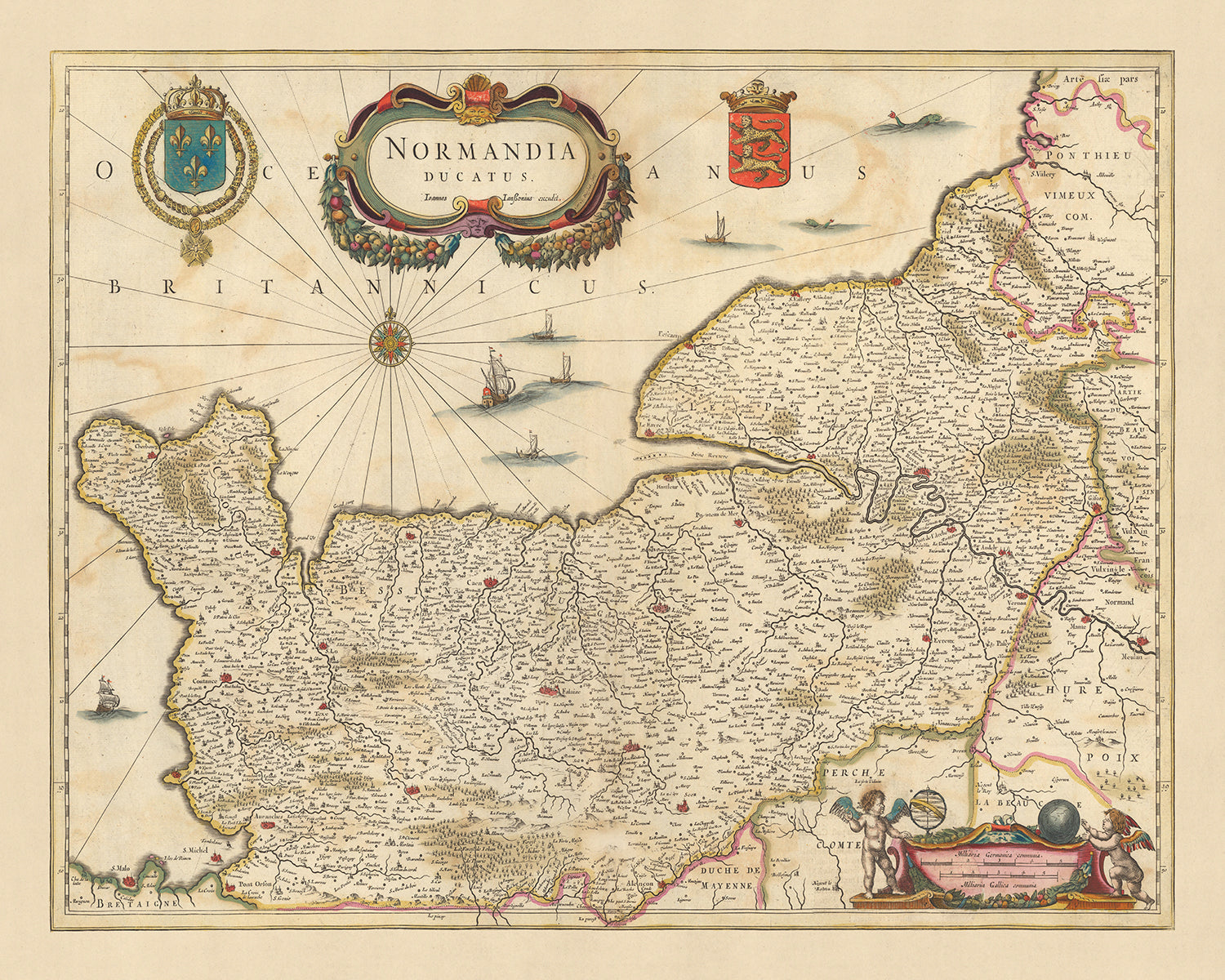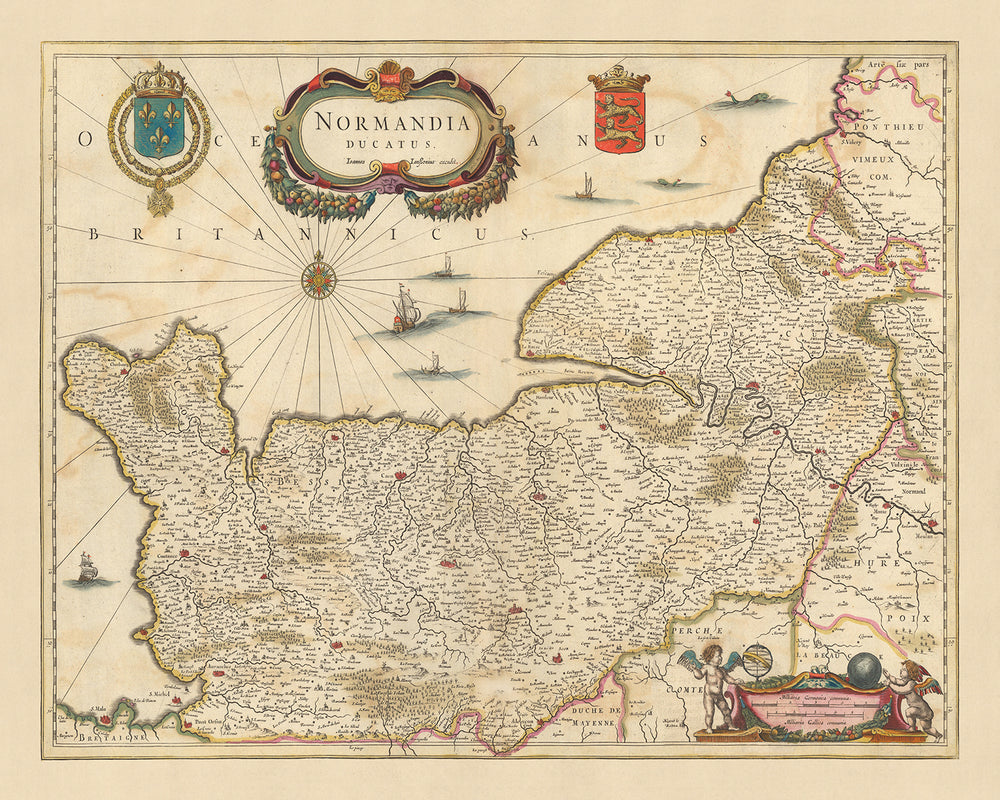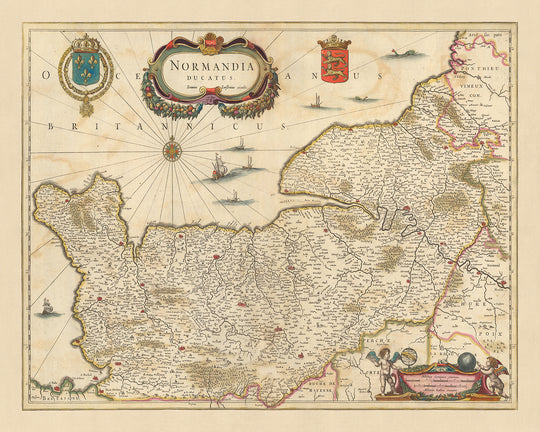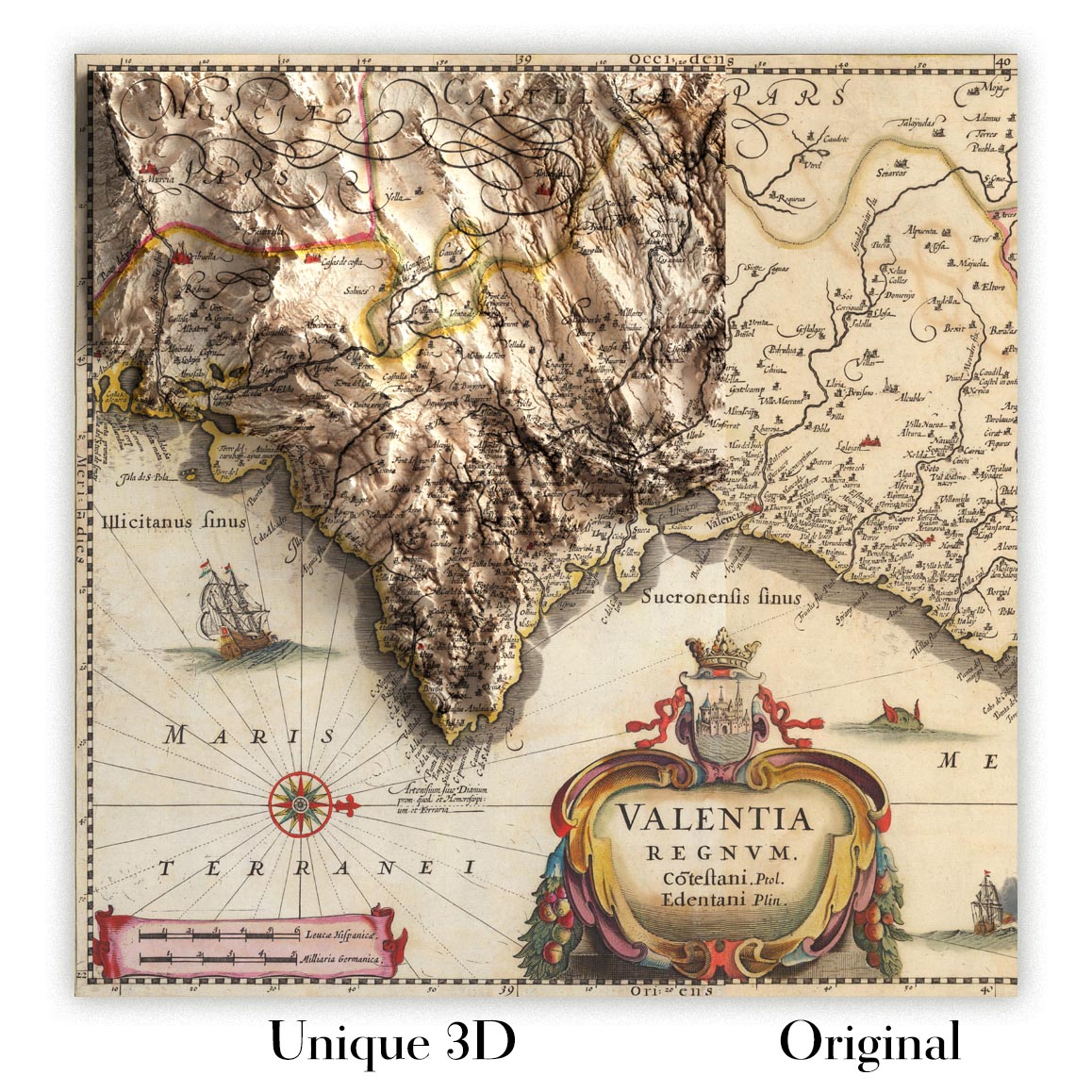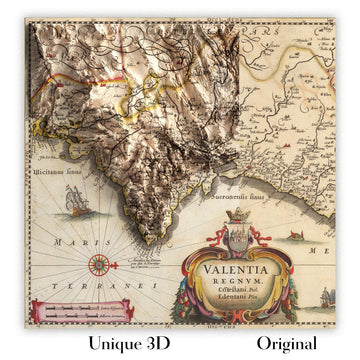- Handmade locally. No import duty or tax
- FREE worldwide delivery
- Love it or your money back (90 days)
- Questions? WhatsApp me any time
Own a piece of history
5,000+ 5 star reviews


Immerse yourself in the rich history of the Duchy of Normandy with this meticulously detailed map crafted by Nicolaes Visscher II in 1690. The map, titled 'Normandia Ducatus' or 'Duchy of Normandy' in English, provides an in-depth look at the political divisions and regions during a pivotal time in French history.
As you explore this map, you will find the historically significant city of Caen, the capital of the Calvados department in the region of Normandy. Known for its historical buildings built during the reign of William the Conqueror, who is buried there, and for the Battle for Caen—heavy fighting that took place in and around Caen during the Battle of Normandy in 1944, causing much destruction to the city.
Le Havre, a major port located on the right bank of the estuary of the river Seine, is also highlighted on this map. The city was rebuilt after being completely destroyed during World War II and is now a UNESCO World Heritage Site. Roen, the historic capital city of Normandy, known for its Notre-Dame cathedral, is also featured prominently.
You will also find Cherbourg-en-Cotentin, a maritime city on the northern tip of the Cotentin Peninsula. Cherbourg harbour is one of the largest artificial harbours in the world. The city was a strategic stronghold during World War II and the German fortifications, built to prevent Allied naval bombardment, are still visible today.
Finally, the map showcases the Normandie-Maine Regional Nature Park, a vast and biodiverse region that spans across the Orne and Mayenne departments. This area, known for its rolling hills, deep forests, and picturesque rivers, is a testament to the natural beauty that Normandy has to offer.
This exquisite map offers not only a geographical perspective but also a unique historical insight into the Duchy of Normandy. It's an essential piece for any history enthusiast or lover of cartography. Explore the intricacies of this map and embark on a journey through time to the Duchy of Normandy in 1690.
Some of the significant locations shown on this map:
Duchy of Normandy
- Caen - Known for its historical buildings built during the reign of William the Conqueror. It was a significant location during the Battle of Normandy in 1944.
- Le Havre - A major port located on the right bank of the estuary of the river Seine. The city was rebuilt after being completely destroyed during World War II and is now a UNESCO World Heritage Site.
- Roen - The historic capital city of Normandy, known for its Notre-Dame cathedral.
- Cherbourg-en-Cotentin - A maritime city on the northern tip of the Cotentin Peninsula. Cherbourg harbour is one of the largest artificial harbours in the world.
- Dieppe - A coastal community in the Arrondissement of Dieppe in the Seine-Maritime department. Known for its strategic significance during the Anglo-French Wars.
- Evreux - The capital of the department of Eure, it was a prosperous city during the Roman era.
- Alençon - Known for its lace-making tradition, it's the capital of the Orne department.
- Rouen - Known for its Notre-Dame cathedral and as the place where Joan of Arc was executed.
- Bayeux - Home to the famous Bayeux Tapestry, which depicts the events leading up to the Norman conquest of England.
- Avranches - Known for the Scriptorial d'Avranches, a museum dedicated to the Mont Saint-Michel manuscripts.
- Falaise - Birthplace of William the Conqueror, the first Norman King of England.
- Lisieux - Known for its rich religious history and as a pilgrimage site.
- Vire - Famous for the Vire River Valley and its gastronomy, particularly andouille sausage.
- Coutances - Known for its Gothic cathedral and the annual Jazz sous les pommiers festival.
- Saint-Lô - Known as "The Capital of the Ruins" after being almost entirely destroyed during World War II.
- Argentan - Known for its heavy involvement in the Battle of Normandy during World War II.
- Honfleur - Known for its picturesque old port, characterized by its houses with slate-covered frontages.
- Pont-Audemer - Known as the "Venise Normande" (Norman Venice) due to the canal network that branches off the Risle river.
- Bernay - Known for its timber-framed houses typical of the Normandy region.
- L'Aigle - Known for its vibrant weekly market that has been taking place since the Middle Ages.
- Verneuil-sur-Avre - Known for its rich history and well-preserved medieval district.
- Mortagne-au-Perche - Known as the "capital" of the Perche natural region.
- Domfront - Known for its medieval ruins and charming old town.
- Conches-en-Ouche - Known for its 11th-century castle and Sainte-Foy church.
- Pont-l'Évêque - Known for its cheese of the same name.
- Louviers - Known for its Church of Notre-Dame, a masterpiece of the Flamboyant Gothic style.
- Elbeuf - Known for its history in the textile industry.
- Gisors - Known for its castle and the Templar's Church.
- Eu - Known for the Château d'Eu and its beautiful gardens.
- Fécamp - Known for its Benedictine Palace, where the famous Benedictine liqueur is produced.
- Montivilliers - Known for its Abbey Church, one of the most important monastic sites in Normandy.
Notable natural phenomena and boundaries:
- The Seine River - One of the major rivers in France, flowing through Paris and into the English Channel at Le Havre.
- The Cotentin Peninsula - Known for its beautiful coastline and the charming towns of Cherbourg and Barfleur.
- Normandie-Maine Regional Nature Park - A vast and biodiverse region known for its rolling hills, deep forests, and picturesque rivers.
- The Bay of the Seine - A major body of water in the English Channel, known for its rich marine life.
- The Alabaster Coast - Known for its white cliffs, including the famous cliffs of Étretat.
Notable historical events between 1600 and 1690:
- The Siege of La Rochelle (1627-1628) - A major event during the French Wars of Religion, it marked the peak of Huguenot power in France.
- The Fronde (1648-1653) - A series of civil wars in France during the minority of Louis XIV, it was a reaction to the centralization of power in Paris and the royal court.
- The Revocation of the Edict of Nantes (1685) - This event led to the large-scale persecution of Huguenots and a major exodus of Protestants from France.
Please double check the images to make sure that a specific town or place is shown on this map. You can also get in touch and ask us to check the map for you.
This map looks great at all sizes: 12x16in (30.5x41cm), 16x20in (40.5x51cm), 18x24in (45.5x61cm), 24x30in (61x76cm), 32x40in (81.5x102cm), 40x50in (102x127cm), 48x60in (122x153cm) and 56x70in (142x178cm), but it looks even better when printed large.
I can create beautiful, large prints of this map up to 90in (229cm). Please get in touch if you're looking for larger, customised or different framing options.
The model in the listing images is holding the 16x20in (40.5x51cm) version of this map.
The fifth listing image shows an example of my map personalisation service.
If you’re looking for something slightly different, check out my collection of the best old maps of Europe and European cities to see if something else catches your eye.
Please contact me to check if a certain location, landmark or feature is shown on this map.
This would make a wonderful birthday, Christmas, Father's Day, work leaving, anniversary or housewarming gift for someone from the areas covered by this map.
This map is available as a giclée print on acid free archival matte paper, or you can buy it framed. The frame is a nice, simple black frame that suits most aesthetics. Please get in touch if you'd like a different frame colour or material. My frames are glazed with super-clear museum-grade acrylic (perspex/acrylite), which is significantly less reflective than glass, safer, and will always arrive in perfect condition.
This map is also available as a float framed canvas, sometimes known as a shadow gap framed canvas or canvas floater. The map is printed on artist's cotton canvas and then stretched over a handmade box frame. We then "float" the canvas inside a wooden frame, which is available in a range of colours (black, dark brown, oak, antique gold and white). This is a wonderful way to present a map without glazing in front. See some examples of float framed canvas maps and explore the differences between my different finishes.
For something truly unique, this map is also available in "Unique 3D", our trademarked process that dramatically transforms the map so that it has a wonderful sense of depth. We combine the original map with detailed topography and elevation data, so that mountains and the terrain really "pop". For more info and examples of 3D maps, check my Unique 3D page.
For most orders, delivery time is about 3 working days. Personalised and customised products take longer, as I have to do the personalisation and send it to you for approval, which usually takes 1 or 2 days.
Please note that very large framed orders usually take longer to make and deliver.
If you need your order to arrive by a certain date, please contact me before you order so that we can find the best way of making sure you get your order in time.
I print and frame maps and artwork in 23 countries around the world. This means your order will be made locally, which cuts down on delivery time and ensures that it won't be damaged during delivery. You'll never pay customs or import duty, and we'll put less CO2 into the air.
All of my maps and art prints are well packaged and sent in a rugged tube if unframed, or surrounded by foam if framed.
I try to send out all orders within 1 or 2 days of receiving your order, though some products (like face masks, mugs and tote bags) can take longer to make.
If you select Express Delivery at checkout your order we will prioritise your order and send it out by 1-day courier (Fedex, DHL, UPS, Parcelforce).
Next Day delivery is also available in some countries (US, UK, Singapore, UAE) but please try to order early in the day so that we can get it sent out on time.
My standard frame is a gallery style black ash hardwood frame. It is simple and quite modern looking. My standard frame is around 20mm (0.8in) wide.
I use super-clear acrylic (perspex/acrylite) for the frame glass. It's lighter and safer than glass - and it looks better, as the reflectivity is lower.
Six standard frame colours are available for free (black, dark brown, dark grey, oak, white and antique gold). Custom framing and mounting/matting is available if you're looking for something else.
Most maps, art and illustrations are also available as a framed canvas. We use matte (not shiny) cotton canvas, stretch it over a sustainably sourced box wood frame, and then 'float' the piece within a wood frame. The end result is quite beautiful, and there's no glazing to get in the way.
All frames are provided "ready to hang", with either a string or brackets on the back. Very large frames will have heavy duty hanging plates and/or a mounting baton. If you have any questions, please get in touch.
See some examples of my framed maps and framed canvas maps.
Alternatively, I can also supply old maps and artwork on canvas, foam board, cotton rag and other materials.
If you want to frame your map or artwork yourself, please read my size guide first.
My maps are extremely high quality reproductions of original maps.
I source original, rare maps from libraries, auction houses and private collections around the world, restore them at my London workshop, and then use specialist giclée inks and printers to create beautiful maps that look even better than the original.
My maps are printed on acid-free archival matte (not glossy) paper that feels very high quality and almost like card. In technical terms the paper weight/thickness is 10mil/200gsm. It's perfect for framing.
I print with Epson ultrachrome giclée UV fade resistant pigment inks - some of the best inks you can find.
I can also make maps on canvas, cotton rag and other exotic materials.
Learn more about The Unique Maps Co.
Map personalisation
If you're looking for the perfect anniversary or housewarming gift, I can personalise your map to make it truly unique. For example, I can add a short message, or highlight an important location, or add your family's coat of arms.
The options are almost infinite. Please see my map personalisation page for some wonderful examples of what's possible.
To order a personalised map, select "personalise your map" before adding it to your basket.
Get in touch if you're looking for more complex customisations and personalisations.
Map ageing
I have been asked hundreds of times over the years by customers if they could buy a map that looks even older.
Well, now you can, by selecting Aged before you add a map to your basket.
All the product photos you see on this page show the map in its Original form. This is what the map looks like today.
If you select Aged, I will age your map by hand, using a special and unique process developed through years of studying old maps, talking to researchers to understand the chemistry of aging paper, and of course... lots of practice!
If you're unsure, stick to the Original colour of the map. If you want something a bit darker and older looking, go for Aged.
If you are not happy with your order for any reason, contact me and I'll get it fixed ASAP, free of charge. Please see my returns and refund policy for more information.
I am very confident you will like your restored map or art print. I have been doing this since 1984. I'm a 5-star Etsy seller. I have sold tens of thousands of maps and art prints and have over 5,000 real 5-star reviews. My work has been featured in interior design magazines, on the BBC, and on the walls of dozens of 5-star hotels.
I use a unique process to restore maps and artwork that is massively time consuming and labour intensive. Hunting down the original maps and illustrations can take months. I use state of the art and eye-wateringly expensive technology to scan and restore them. As a result, I guarantee my maps and art prints are a cut above the rest. I stand by my products and will always make sure you're 100% happy with what you receive.
Almost all of my maps and art prints look amazing at large sizes (200cm, 6.5ft+) and I can frame and deliver them to you as well, via special oversized courier. Contact me to discuss your specific needs.
Or try searching for something!







